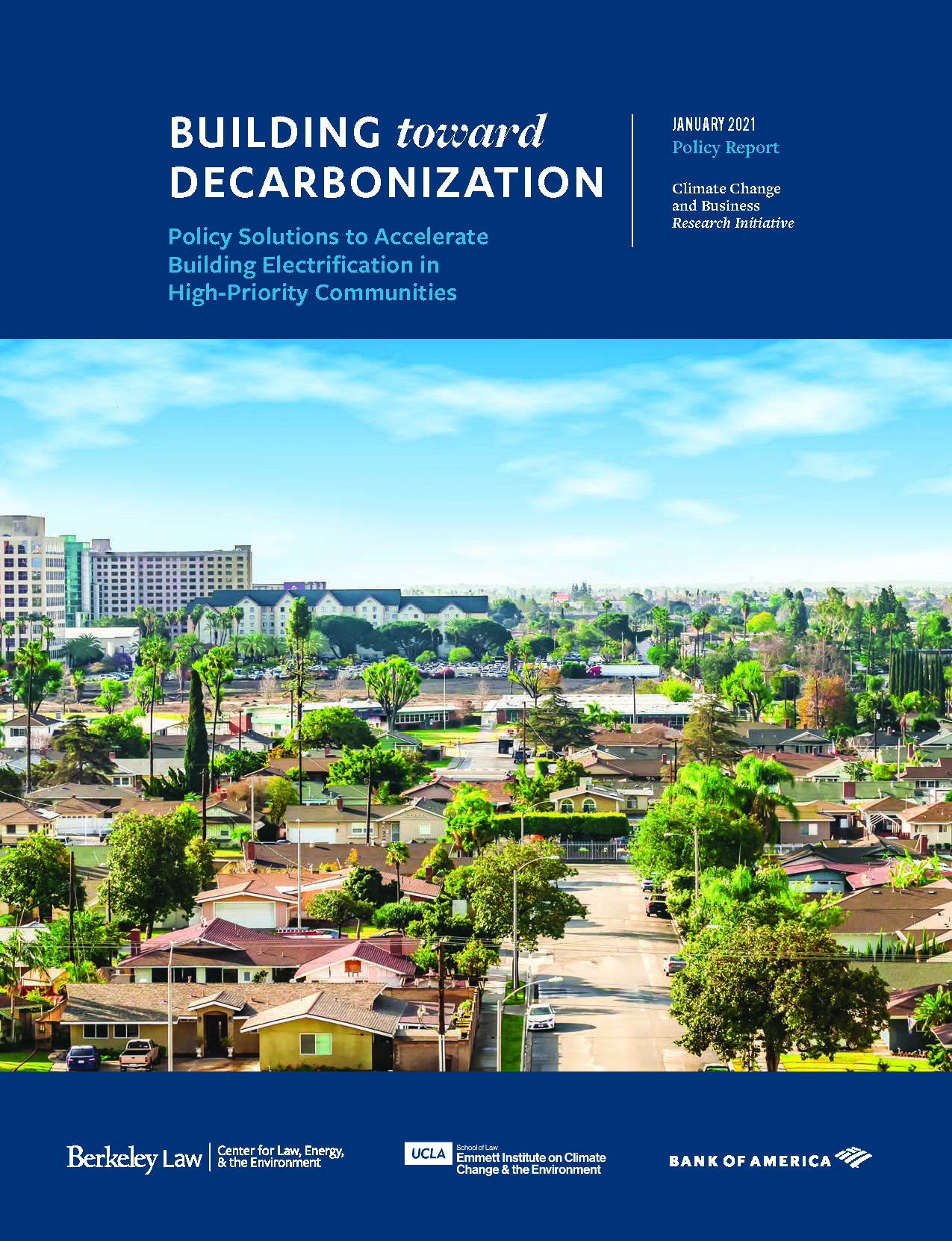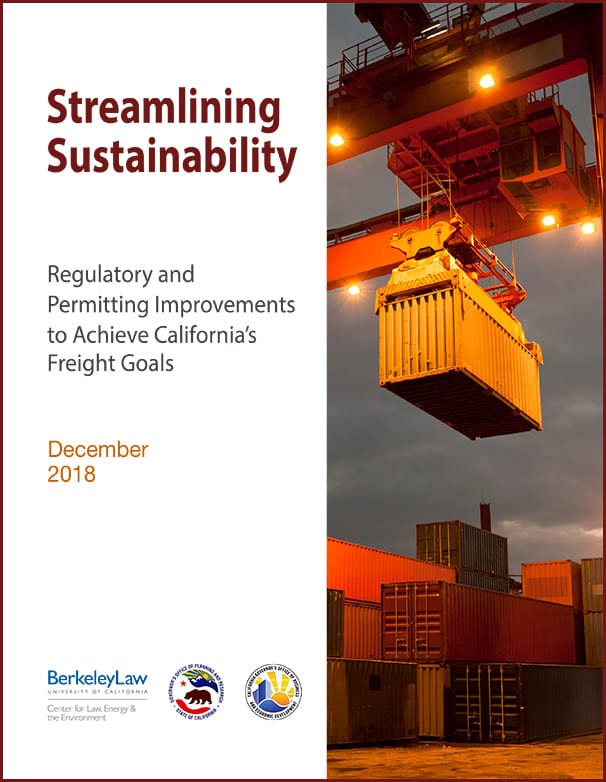
The Ports of Los Angeles and Long Beach are major polluters in the region but also potential models for climate action — if they can electrify their equipment, from fork lifts to cranes. A new report released by UCLA Law’s Emmett Institute on Climate Change and the Environment and UC Berkeley Law’s Center for Law, Energy & the Environment (CLEE) —A Heavy Lift: Policy Solutions to Accelerate Deployment of Zero-Emission Cargo Handling Equipment at the Ports of Long Beach and Los Angeles and Beyond—surveys the biggest obstacles to speedy electrification and makes some recommendations.
Greenhouse gas emissions at the Ports come from three main sources: ships, heavy-duty vehicles, and cargo handling equipment (“CHE”). Cargo handling equipment is the third largest source of emissions accounting for approximately 14 percent of the Ports’ total greenhouse gas emissions. The Ports have replaced some fossil-fuel powered equipment with zero-emission models as they work toward goals set forth in their Clean Air Action Plan, including a goal to transition to 100 percent zero-emission CHE by 2030. However, more work is needed to fully transition the Ports large CHE fleet to zero-emission models. While some consider cargo handling equipment the “low hanging fruit” of port emissions reductions, there remain challenges for the transition to zero emissions. Some of the needed ZE technology is still being developed, and communities and workers have raised concerns around the potential for job loss.
To address these concerns, the law schools hosted a convening of experts from a variety of industries, including environmental, public health, environmental justice, labor, business, and government sectors. We discussed the challenges and opportunities of decarbonizing cargo handling equipment at the Ports. The report discusses the top barriers to transitioning to electric CHE models and proposes solutions to overcome these barriers.
The report dives into the following barriers:
- Inadequate grid and charging infrastructure to support zero-emission cargo handling equipment and lack of substantial planning and funding to install necessary and timely infrastructure.
- Evolving zero-emission technology for some types of cargo handling equipment and high upfront costs.
- Fear among communities and workers of job loss and of increased emissions from expanded port activities.
The report then recommends several solutions, including:
- The Ports and utilities, chiefly Southern California Edison and Los Angeles Department of Water and Power, could proactively deploy “no regret” infrastructure, including increasing grid capacity and upgrading distribution networks that will be needed regardless of how zero-emission cargo handling equipment is powered.
- The California Legislature; the Air Resources Board; and/or the South Coast Air Quality Management District, using their existing authority grounded in air pollution control, could create technology-forcing mandates and clear, enforceable implementation deadlines, with penalties for non-compliance, to catalyze the zero-emission cargo handling equipment transition. Where technology is not readily commercially available, regulations could incorporate adequate flexibility and sufficient lead time for entities to meet the mandate.
- State and local government could implement policies to promote job preservation, local job creation, and worker training, such as programs that encourage ports and terminal operators to partner with local training organizations to upskill and reskill the workforce to use the new vehicles and technologies.

Given the importance of the Ports to worldwide commerce, they could help inform climate action at ports around the globe, if they and policy makers can collaborate to achieve these zero-emission goals.
If you want to dive into this topic further, join us for a webinar discussion today, Thursday, November 16th at 1pm PT when we’ll discuss solutions with panelists from Southern California Edison, the Port of Los Angeles, and Earthjustice (RSVP here).
This report is ultimately part of a series on business solutions to address climate change. Read more: A Heavy Lift: Policy Solutions to Accelerate Deployment of Zero-Emission Cargo Handling Equipment at the Ports of Long Beach and Los Angeles and Beyond.
This post was co-authored by Beth Kent and Gabi Rosenfeld.
Today, the Center for Law, Energy and the Environment (CLEE) at Berkeley Law and the Emmett Institute on Climate Change and the Environment at UCLA Law are releasing a new report, Building toward Decarbonization, which highlights the key barriers and policy solutions to accelerate building electrification retrofits and new construction in California’s high-priority communities.

Commercial and residential building consumption of natural gas—to power heating and cooling, water heating, and cooking equipment—is currently responsible for about 10 percent of California’s greenhouse gas emissions, as well as harmful indoor air pollution. Transitioning the state’s buildings from natural gas to all-electric—such as electric heat pumps, electric water heaters, and induction cooktops—is thus one of the top priorities for statewide decarbonization and carbon neutrality by 2045. Over 40 cities have already taken municipal action to phase out building natural gas use, including all-electric new construction ordinances in Oakland, San Francisco, and San Jose.
But the transition presents significant regulatory, economic, and infrastructure challenges.
Developing a statewide strategy and timeline for the transition will be essential to achieve state decarbonization goals, and as the new report describes, this strategy will be most effective if it is targeted first toward communities and building types that will benefit most from state support and incentives. These include:
- Lower-income and disadvantaged communities with the least financial resources and the most to gain from improved air quality;
- Communities currently investing in new building construction;
- Communities with aging gas infrastructure already in need of replacement;
- Communities with an expressed willingness to transition; and
- Communities rebuilding from recent wildfires.
In a state that chronically under-builds new housing and will still have millions of pre-1990 homes in place in 2050, the retrofit challenge is especially urgent. And retrofitting existing buildings in lower-income communities—which tend to have more renters, more multifamily buildings, older construction, and less available capital—is a particularly thorny challenge: replacing gas HVAC, water, and cooking systems with all-electric alternatives can save money in the long run, but upfront installation costs are high, and landlords may have limited incentives to upgrade appliances when they aren’t responsible for utility bills. In addition, existing utility business and regulatory frameworks can limit incentives to accelerate the transition (or in some cases may bar the removal of gas service), compounding the after-effects of a long history of service denial in some communities.
All of these challenges overlay the systemic risk of developing stranded assets in the natural gas distribution network if the transition is insufficiently structured, which could threaten the financial viability of utilities, physical safety of the system, and costs for customers who can’t afford to make the switch independently.
Fortunately, state leaders have an opportunity to address these challenges by developing a reasoned plan to manage the electrification transition in order to meet state climate goals and address the needs of stakeholders including high-priority communities and natural gas system workers. Building Toward Decarbonization recommends these priority solutions:
- Setting a clear timeline (via executive order or legislation) for the long-term phase-out of natural gas to provide certainty for utilities and investors and mitigate stranded asset impacts on customers.
- Clarifying electric and utilities’ legal “obligation to serve” to ensure that electrical service can be substituted for gas service so long as energy access is maintained.
- Crafting a structured plan for a just transition for gas system workers including funding, retraining support, and targeted early retirement opportunities.
- Communicating the air quality benefits and performance qualities of electric stoves, hot water heaters, and other equipment to build public support for the transition.
Ultimately, California’s achievement of carbon neutrality by 2045 will hinge on this transition, particularly as the state continues to advance its goal of system-wide resilience through load management and flexibility.
You can read the full report here.
To learn more about potential solutions to accelerate the building electrification transition, register for our free webinar on Tuesday, February 23 at 1pm. Speakers include:
- Michael Colvin of Environmental Defense Fund
- California Public Utilities Commissioner Cliff Rechtschaffen
- Abigail Solis of Self Help Enterprises
They will join us to discuss priorities and opportunities for the coming decade of the decarbonization effort. Register here.
This post is co-authored with Ted Lamm and cross-posted on Legal Planet.
 A new report released today from UC Berkeley School of Law, Streamlining Sustainability: Regulatory and Permitting Improvements to Achieve California’s Freight Goals, offers state and local policy reforms for California leaders to increase the sustainability and efficiency of the state’s freight system.
A new report released today from UC Berkeley School of Law, Streamlining Sustainability: Regulatory and Permitting Improvements to Achieve California’s Freight Goals, offers state and local policy reforms for California leaders to increase the sustainability and efficiency of the state’s freight system.
Freight is responsible for hundreds of thousands of jobs in California and feeds commerce and agriculture throughout the state and the entire nation. But the trains, trucks, aircraft, and ocean vessels that ship goods throughout California are responsible for a disproportionate amount of greenhouse gas emissions and harmful air pollutants (such as nitrogen oxides and sulfur dioxide), particularly in disadvantaged communities near railyards and ports. A range of strategies and technologies, from electrified heavy-duty trucks to increasing the use of rail at ports, can modernize the system and reduce emissions. But these projects can be challenging to implement in the current legal and policy ecosystem.
To reduce these impacts and maintain competitiveness, UC Berkeley Law’s Center for Law, Energy and the Environment (CLEE) partnered with the Governor’s Offices of Planning and Research (OPR) and Business and Economic Development (GO-BIZ) to offer recommendations to increase the rate that cleaner freight technologies are integrated into the system, while helping the state achieve the goals in 2016’s Sustainable Freight Action Plan.
Top recommendations include:
- Convening sustainable freight “red teams” to conduct holistic analysis and clear local and state-level permitting roadblocks for high-priority infrastructure projects;
- Facilitating “tiered” review under the California Environmental Quality Act to comprehensively assess impacts and benefits of related freight projects; and
- Increasing the use of community benefit agreements and project labor agreements to earn the support of local communities and labor groups most likely to be affected by new projects or technological developments.
The report is informed by a stakeholder convening held in the Governor’s Office, organized and moderated by UC Berkeley School of Law. It describes a range of other measures, from a messaging campaign to raise public awareness about the freight system to pilot programs that allow industry members to securely share key data, that could increase support for sustainable freight from the policy, industry, and community and environmental advocacy spheres.
The implications of a sustainable freight system are significant. Freight is directly involved in approximately one third of the California economy, including both exports and imports. For example, California is the largest supplier of food to the rest of the nation and the point of entry for the vast majority of goods imported from Asia. California’s freight system leaders will need to maximize its efficiency to retain this position of prominence while protecting California residents and workers. We hope these recommendations will help California achieve its ambitious emission reduction, public health, and economic competitiveness goals.
To download the new report, click here.


